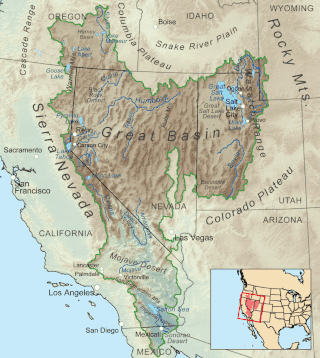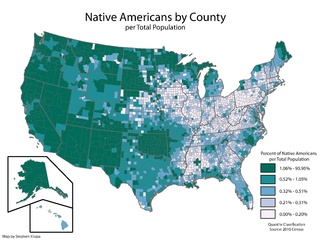
Tooele County is a county in the U.S. state of Utah. As of the 2020 United States Census, the population was 72,698. Its county seat and largest city is Tooele. The county was created in 1850 and organized the following year.

The Great Basin is the largest area of contiguous endorheic watersheds, those with no outlets to the ocean, in North America. It spans nearly all of Nevada, much of Utah, and portions of California, Idaho, Oregon, Wyoming, and Baja California. It is noted for both its arid climate and the basin and range topography that varies from the North American low point at Badwater Basin in Death Valley to the highest point of the contiguous United States, less than 100 miles (160 km) away at the summit of Mount Whitney. The region spans several physiographic divisions, biomes, ecoregions, and deserts.

The Northern Paiute people are a Numic people that has traditionally lived in the Great Basin region of the United States in what is now eastern California, western Nevada, and southeast Oregon. The Northern Paiute pre-contact lifestyle was well adapted to the harsh desert environment in which they lived. Each tribe or band occupied a specific territory, generally centered on a lake or wetland that supplied fish and waterfowl. Communal hunt drives, which often involved neighboring bands, would take rabbits and pronghorn from surrounding areas. Individuals and families appear to have moved freely among the bands.

The Bear River Massacre, or the Engagement on the Bear River, or the Battle of Bear River, or Massacre at Boa Ogoi, took place in present-day Franklin County, Idaho, on January 29, 1863. After years of skirmishes and food raids on farms and ranches, the United States Army attacked a Shoshone encampment gathered at the confluence of the Bear River and Battle Creek in what was then southeastern Washington Territory, near the present-day city of Preston. Colonel Patrick Edward Connor led a detachment of California Volunteers as part of the Bear River Expedition against Shoshone tribal chief Bear Hunter. Hundreds of Shoshone men, women, and children were killed near their lodges; the number of Shoshone victims reported by local settlers was higher than that reported by soldiers.
The Shoshone or Shoshoni are a Native American tribe with four large cultural/linguistic divisions:

The Goshutes are a tribe of Western Shoshone Native Americans. There are two federally recognized Goshute tribes today:

The Indigenous peoples of the Great Basin are Native Americans of the northern Great Basin, Snake River Plain, and upper Colorado River basin. The "Great Basin" is a cultural classification of indigenous peoples of the Americas and a cultural region located between the Rocky Mountains and the Sierra Nevada, in what is now Nevada, and parts of Oregon, California, Idaho, Wyoming, and Utah. The Great Basin region at the time of European contact was ~400,000 sq mi (1,000,000 km2). There is very little precipitation in the Great Basin area which affects the lifestyles and cultures of the inhabitants.
The Snake War (1864–1868) was an irregular war fought by the United States of America against the "Snake Indians," the settlers' term for Northern Paiute, Bannock and Western Shoshone bands who lived along the Snake River. Fighting took place in the states of Oregon, Nevada, and California, and in Idaho Territory. Total casualties from both sides of the conflict numbered 1,762 dead, wounded, or captured.

The Dann Sisters, Mary Dann (1923–2005) and Carrie Dann (1932–2021), were Western Shoshone elders who were spiritual leaders, ranchers, and cultural, spiritual rights and land rights activists. They challenged the federal government over uses of their tribe's traditional land, in a case that reached the United States Supreme Court as U.S. v. Dann.

Western Shoshone comprise several Shoshone tribes that are indigenous to the Great Basin and have lands identified in the Treaty of Ruby Valley 1863. They resided in Idaho, Nevada, California, and Utah. The tribes are very closely related culturally to the Paiute, Goshute, Bannock, Ute, and Timbisha tribes.

The Confederated Tribes of the Goshute Reservation is located in Juab County, Utah, Tooele County, Utah, and White Pine County, Nevada, United States. It is one of two federally recognized tribes of Goshute people, the other being the Skull Valley Band of Goshute Indians of Utah.
The Timbisha are a Native American tribe federally recognized as the Death Valley Timbisha Shoshone Band of California. They are known as the Timbisha Shoshone Tribe and are located in south central California, near the Nevada border. As of the 2010 Census the population of the Village was 124. The older members still speak the ancestral language, also called Timbisha.

The History of Utah is an examination of the human history and social activity within the state of Utah located in the western United States.

The Duck Valley Indian Reservation was established in the 19th century for the federally recognized Shoshone-Paiute Tribe. It is isolated in the high desert of the western United States, and lies on the state line, the 42nd parallel, between Idaho and Nevada.

Corbin Harney was an elder and spiritual leader of the Newe people. Harney reportedly inspired the creation in 1994 of the Shundahai Network, which works for environmental justice and nuclear disarmament. The Shundahai Network plays a key role in organizing non-violent civil disobedience aimed at bringing about the closure of the Nevada Test Site, used for testing nuclear weapons, which is located on Western Shoshone land.
The Treaty of Ruby Valley was a treaty signed with the Western Shoshone in 1863, giving certain rights to the United States in the Nevada Territory. The Western Shoshone did not cede land under this treaty but agreed to allow the U.S. the "right to traverse the area, maintain existing telegraph and stage lines, construct one railroad and engage in specified economic activities. The agreement allows the U.S. president to designate reservations, but does not tie this to land cessions."

Gosiute is a dialect of the endangered Shoshoni language historically spoken by the Goshute people of the American Great Basin in modern Nevada and Utah. Modern Gosiute speaking communities include the Confederated Tribes of the Goshute Reservation and the Skull Valley Band of Goshute Indians.

The Te-Moak Tribe of Western Shoshone Indians of Nevada is a federally recognized tribe of Western Shoshone people in northeastern Nevada.

Spring Valley Wind Farm is Nevada's first wind farm. The farm is owned and operated by Pattern Energy. The facility is located in Spring Valley, northwest of Great Basin National Park and approximately 30 miles (48 km) east of Ely, Nevada. The 151.8 megawatts (203,600 hp) plant utilizes 66 2.3 megawatts (3,100 hp) wind turbines and occupies 77 acres (31 ha) in the center of Spring Valley, which consists of 7,673 acres (3,105 ha).

Indigenous peoples have lived in the area now known as the state of Utah for thousands of years. Today they are divided into five main groups: Utes, Goshutes, Paiutes, Shoshone, and Navajo. Each occupies a different region within the state, many of which regions extend across borders into other states. In the 2010 census, there were a total of 32,927 American Indian and Alaska Natives living within the state, which totaled to 1.19% of the total population of Utah.


















